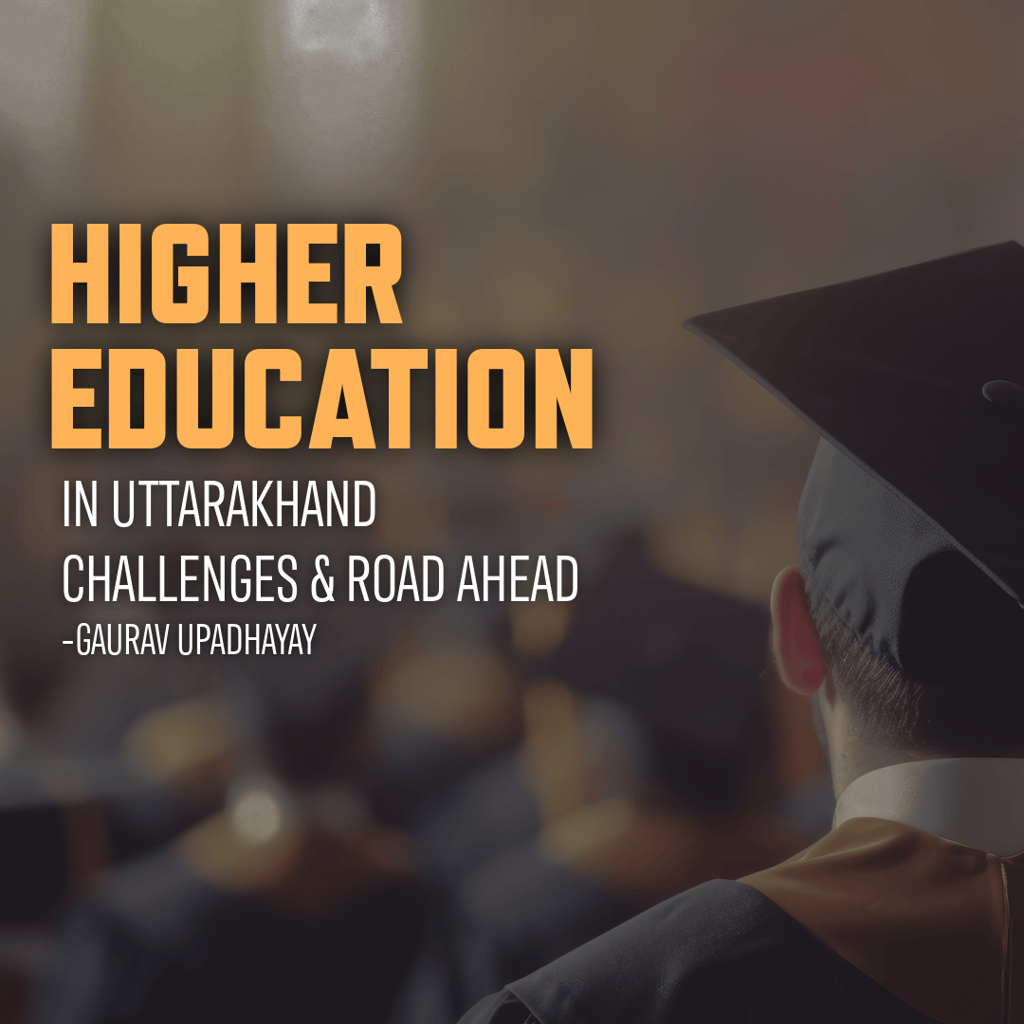Reimagining Higher Education in Uttarakhand | Challenges and Future Strategies
Explore the evolving landscape of higher education in Uttarakhand. Learn about key challenges, policy reforms, and innovative solutions shaping the future of education in the state.
RESEARCHINSIGHTS
Gaurav Upadhyay
4/28/20256 min read


The higher education sector in Uttarakhand, once imagined as a shining example of cognitive capability and human resource development, today stands at a decisive stage.
Despite the expansion of higher educational institutes, degree colleges, and universities (government-aided and private both) across the state, the qualitative as well as robust foundation of higher education has slowly diminished, leading to rising apprehensions among policy formulators, educators, guardians, and students alike.If Uttarakhand endeavors to reconcile itself with the national aspirations like Viksit and Shikshit Bharat 2047 alongside global knowledge benchmarks, a serious and strategic intervention is the need of the hour.
One of the most common and trivial ailments distressing the higher education outlook in the state is the authority to license institutions, which, fortunately or unfortunately, has developed an ecosystem conducive to ill practices such as corruption and profit manipulation. This rent-seeking behavior has had detrimental effects on the status ohigher education in Uttarakhand.
In a couple of instances, it is observed that affiliations, accreditations, and prior permissions are being granted without necessary verifications and appropriate safeguards on major academic aspects such as academic quality, faculty strength, faculty qualifications & infrastructural adequacy.
This regulatory governance lapse has led to the mushrooming of substandard higher educational institutions or colleges in the state that give precedence to economic profits over pedagogy.
The Government of Uttarakhand is taking substantial steps in this regard; however, controlling such governance failures demands urgent and swift action from policymakers.
The government must take urgent cognizance of all such matters linked with systemic flaws, by instituting merit-based, transparent, and accountable processes for licensing, accreditation, and affiliation.
A state government-empowered independent regulatory authority insulated or shielded from any sort of political pressure, external or internal, could play a vital role in restoring integrity to the system.
Equally concerning is the underfunding of research initiatives in the state. Continual resource scarcity with a prolonged lack of funding has caused a great deal of damage to the research ecosystem in the state.
It is very well understood that research forms the backbone of a vibrant higher education ecosystem, driving innovation, knowledge creation, and societal progress.
In Uttarakhand, however, universities and colleges are primarily teaching-focused, with little emphasis on research output and research-focused teaching.
The dearth of adequate grants or proper financial support, fellowships to research scholars, and research infrastructure has dispirited and discouraged faculty members and students from striving for meaningful research endeavors.
It is necessary that the state government earmarks a considerable portion of the annual budget (that too, a budget specifically for the education budget, specifically for promoting interdisciplinary research, industry-academia collaborations, and research incubation centers).
Another area that requires urgent policy innovation is the amalgamation of vocational education into mainstream higher education, which has been a talking point in the recently implemented New Education Policy 2020 (NEP).
Conventional academic programs, often heavy on theoretical content, fail to equip learners with the practical skills needed in today's dynamic and ever-changing, fluid employment landscape.
The government should emphasize formulating regulatory guidelines mandating higher educational institutions to incorporate entrepreneurship-oriented vocational modules, paid or unpaid internships, and skill-based certifications into their curriculum.
Collaboration with public sector undertakings, privately owned industries, and emerging start-ups could provide real-world exposure to students at a young age and upgrade their employability quotient.
The introduction of project-based assessments, hackathons, live case studies, and community-based learning programs can significantly rejuvenate the academic culture within the state, making it more dynamic, engaging, and aligned with real-world challenges.
It is disappointing that despite NEP 2020, most of the syllabus or the curriculum itself remains outdated or obsoleted, mirroring a wide disconnect between the rapidly evolving industry requirements and the skills imparted at higher educational institutions.
NEP 2020 has improved the situation considerably, but it requires serious course correction.
For instance, while domains like Artificial Intelligence (AI), Machine Learning (ML), Renewable Energy, Data Analytics, and E-Marketing are broadening globally, most undergraduate, postgraduate, and vocational courses in Uttarakhand remain linked to an old and outdated syllabus designed back based on different market scenarios.
Although the government has shown keen interest in improving this through reforms, curriculum reform must be a continuous, constant, and consultative process, incorporating experts from academia and industry alongside policymakers, including top-level bureaucrats.
Integrating new-age infrastructure with emerging technologies, enhancing soft skills, developing critical thinking, and infusing entrepreneurship modules into the curriculum are the need of the hour.
Simultaneously with curriculum-based reforms, there is an urgent need for a complete overhaul of teaching methodologies, which are extremely bookish.
Teaching must emerge from rote and passive learning towards dynamic, practically demonstrated, student-centric models that give precedence to efficient problem-solving, a new way of experiential learning, and critical inquiry.
Faculty Development Programs (FDPs) are often conducted by various universities in Uttarakhand across the Science, Social Science, and Commerce streams. However, the effectiveness of these programs remains a matter of great concern, as there has been little noticeable improvement in teaching quality. This raises an important issue: there must be a robust system to ensure accountability among the organizers and participants. Without proper oversight and evaluation, the desired outcomes of these programs cannot be achieved.
To make FDPs more impactful on the ground, they must be institutionalized as part of a holistic faculty development strategy through regular workshops. This involves reskilling educators in modern pedagogical practices, incorporating modern technology into classrooms, and urging interactive learning techniques. Only by ensuring that these programs are both consistent and outcome-oriented can we expect substantial refinements in the quality of teaching and learning in higher education institutions within Uttarakhand.
In this regard, the efforts of the current Vice-Chancellor of Kumaun University, Nainital, Prof. Diwan Singh Rawat, deserve commendation. This is a prime example of how the inclusion of an academician with exceptional credentials, a high caliber, and extensive research experience can positively impact the system. The appointment of such a distinguished individual at the helm of the institution underscores the importance of meritocracy in leadership selection. His efforts are already bearing fruit, as evidenced by Kumaun University’s recent partnership with the prestigious Indian Institute of Science (IISC) Bangalore on a collaborative project. This initiative not only reflects the Vice-Chancellor’s vision for academic excellence but also positions the university as a growing hub for cutting-edge research and innovation in the coming time.
To ensure accountability and sustained improvement within the higher education system, the government must also implement a resilient framework of student feedback and peer reviews across higher educational institutions. Student assessment of courses and respective instructors, when conducted fairly and constructively, can provide invaluable insights into pedagogical effectiveness and institutional shortcomings. In the same way, faculty peer review systems can encourage a culture of academic excellence and self-reflection.
This exercise must be carried out in a constructive manner, as improper handling of such data can create issues and undermine the confidence of both students and faculty. To mitigate such risks, anonymity should be maintained while collecting feedback and reviews, ensuring that all participants feel safe and secure in providing honest and open input.
To sum it up, the higher education sector in Uttarakhand is unquestionably facing significant challenges. However, as formidable as these issues may seem, they are not unconquerable or insurmountable. As discussed previously, we have seen how a university like Kumaun University, Nainital, is being reshaped considerably, especially in the areas of research and publications in the science stream, owing to the capable leadership of the current Vice-Chancellor. While there is still a long way to go, we can expect substantial changes across the state, particularly in university-affiliated colleges. His Excellency, the Hon'ble Governor, Hon'ble Chief Minister, and Hon'ble Minister for Higher Education are deserving of praise for incorporating meritocracy in the appointment of Vice-Chancellors. As the saying goes, “A team is only as good as its leader,” and it is the Vice-Chancellor's vision that is carried out by his subordinates on the ground, influencing the entire academic ecosystem.
A comprehensive revamp by integrating systemic reforms is quintessential to meet both present requirements and upcoming challenges.
The future progression of Uttarakhand’s higher education must be catalysed by a long-term vision, not merely in terms of regulatory adherence, but as a mission towards drafting knowledge hubs that foster innovation, inclusiveness, and global competitiveness.
Therefore, it is crucial that the state government redefines its role from that of a mere 'regulator' to a proactive 'promoter and facilitator' of higher education.
By adopting a research-driven approach, Uttarakhand cannot only revitalize its higher education system but also empower its youth to drive the journey of the hilly state towards sustainable and inclusive development in the times to come.
This aligns seamlessly with the vision of Viksit Bharat @2047 coined by Prime Minister Shri Narendra Modi, where the government has a key role to play in nurturing a prosperous, self-reliant, just, and globally competitive India.As we say generally, "Gyaanam Sarvottamam Pathaha" (Knowledge is the highest path), it is through the pursuit of knowledge, innovation, and a very spirit of inquiry that Uttarakhand will realize its true potential in the years ahead.
